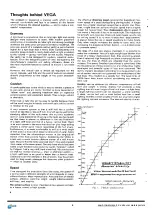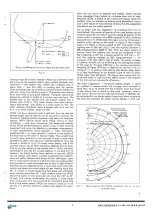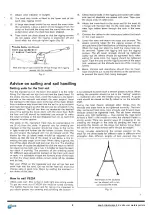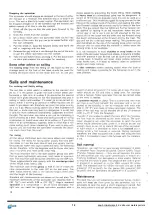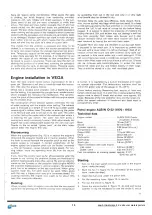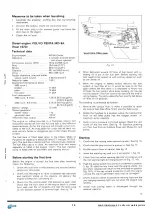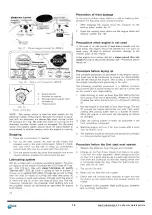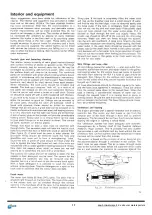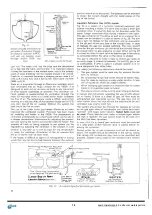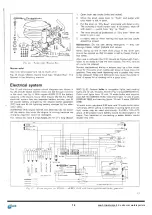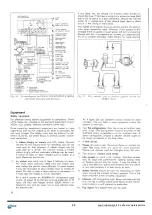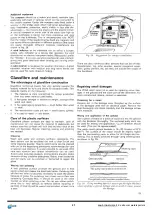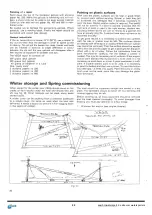
Instrumenttavla
Instrument panel
1 Brytare, kompassbelysning
Switch, compass light
2 Brytare, topplanterna
Switch, masthead light
3 Brytare, lanternor
Switch, navigation lights
t Brytare, flakt
Switch, fan
5 Oljetryck
Oil pressure
6 Laddning, ^
Charging '
7 Laddning =
Chargng =
Brytare.spndarljus _J_
(ej monterad)
Switch, spreader light
(not fitted)
Givare vattentemp.
Water temp switch
Givare oljetryck
Oil pressure switch
Styrbordlanterna
Starboard light
Babordlanterna
Port light
Topplanterna
Masthead light
Lampa, skans
Fore cabin light
Ldslampa ruft SB
Reading light,cabin
Ldslampa ruff BB
Reading light cabin
El. uttag
El. connection
Ansl for spridarljus
Connection for spreader
light
8. Startnyckel
Starter key
9 Kylvattentermometer
Cooling water temperature
If any lamp, fan, etc should not function when turned o n ,
check the fuse. If the fuse is alright it is either the lamp (fan)
that is out of action or a bad c o n n e c t i o n . Should the fuse be
b l o w n fit a replacement. If this should b l o w there is s h o r t
circuit in the wiring or the fixture.
The A L B I N 0 - 2 2 engine requires electric current for ignition,
even w h e n started by hand. H o w e v e r if the battery is d i s -
c h a r g e d there is usually enough power left for hand starting.
Should this fail, it is p o s s i b l e to connect dry batteries (fig.
27) or a suitable transistor radio battery for hand starting.
Fig. 26. Circ/at diagram for VEGA. VOLVO PENTA MD6A
with starter generator and alternator.
Fig. 27. Dry batteries i/sed to prodnce ignition current for
ALBIN 0-22.
Equipment
Safety equipment
For o f f s h o r e racing certain equipment is compulsory. S o m e
of the items are included in the Standard equipment of y o u r
V E G A , (e.g. pulpits, lifelines, handrails, pump etc).
Rules regarding c o m p u l s o r y equipment are based on long
e x p e r i e n c e and can be j u d g e d to be w h a t is necessary for
any long v o y a g e . The safety rules may be different in dif-
f e r e n t c o u n t r i e s , but listed b e l o w is w h a t is usually c o n s i d -
ered necessary.
1. A rubber dinghy or liferaft with C 0
2
bottle: S p e c i a l
liferafts fill the requirements for lifesafing, but can be
used only for that purpose. A r u b b e r dinghy can be
used also as a tender. For inshore sailing a s i m p l e
r u b b e r dinghy w i t h o u t automatic inflating can be used.
If t o w e d or k e p t on deck inflated such a dinghy is a
g o o d lifesaving devise too.
2. A n anchor w i t h w a r p and at least 2 fathoms of c h a i n :
The short chain prevents chafe near the anchor and
also makes the anchor more efficiënt. In some w a t e r s
it may be necessary to use a longer chain or maybe all
chain. On rock or kelp a heavy a n c h o r is necessary —
in t h a t case the shape is not so important.
A s a storm anchor an A D M I R A L T Y (Fisherman) t y p e
a n c h o r of about 18 kg (40 Ibs) is to be p r e f e r r e d . A 12
kgms (25 Ibs) light-weight anchor ( C Q R , Northill or
D a n f o r t h ) can also be used, but is less efficiënt than
the heavier one.
A n 9 kgms (20 Ibs) D a n f o r t h anchor should be used
normally. This will hold in most conditions unless the
b o t t o m is very bad.
3. Two fire extinguishers: One has to be of certified type
(min. 2 kg). One extinguisher must be mounted on the
b u l k h e a d easily accessible or in an unlocked seat. A
spare extinguisher (maybe a smaller model) ought to
be easily accessible in the fore cabin.
4 A first aid kit.
5. Flares (at least 6 red). Parachute flares or rockets are
best. Red hand flares are good for short distances.
Flares and rockets must be changed every 3rd year.
6. T w o powerful electric hand lamps.
7. Life jackets for each crew member. Certified j a c k e t s
may be large and c u m b e r s o m e . Special sailing v e s t s
or floating jackets may be better. It may be better to
use a less effective, easily w o r n floation than one w h i c h
is not used because it is less handy to wear.
8. Safety harness s h o u l d be w o r n by everybody on deck
when leaving the c o c k p i t in heavy weather. This is the
most important piece of safety equipment.
9. Lifebuoy with self-igniting light. Buoys are best painted
in an orange or y e l l o w c o l o u r to be easily visible. Horse-
shoe model in a soft material is preferable.
10. Fog signal: Any simple horn can be used.
18
20

